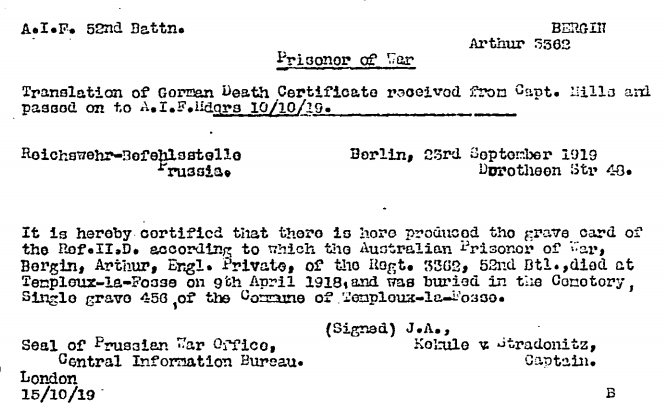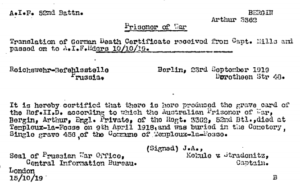In May 1927 William Davey of Amaroo Public School wrote the following letter to the Officer in Charge at Victoria Barracks:
Dear Sir
I am writing to you on behalf of an old man, Patrick Bergin, whose only son was killed in the war.
Mr Bergin is 88 years old, is very feeble and is living quite alone – his only other child, a daughter, having to leave home to earn her living in Sydney.
The old man has only his pension to live on, and, as aforesaid, is in very feeble health and failing visibly. His boy was all he had, and he was killed. The old man grieves very much, and more so because he has no memento of his son save a photo of his grave in a German cemetery.
Should he not be entitled at least to his boy’s medals? Alas, should not a photograph of his last resting place … be available?
You, sir, would be doing a kindly action, but one only just, if you would investigate this case, and if possible have the boy’s medals, or any other memento, sent to the old man. It would cheer his last days and alleviate his sorrow,
Yours faithfully William E Davey (ex AIF)
The Officer in Charge was unable to fulfil William’s request; Arthur Bergin’s war medals and photographs of his grave had been issued to Mary Bergin, Arthur’s sister and nominated next of kin, in 1922. Patrick survived a further five years, he died in Young in February 1932.
Arthur Bergin was born in Molong in 1887 to Patrick Bergin, an Amaroo farmer, and his wife Catherine nee Reswick. When Arthur was six years old, and Mary nine, Catherine passed away.
Little is known about Arthur’s childhood or teenage years. He enlisted for WWI service in Brisbane in January 1916. He gave his occupation as labourer, and was 29 years of age.
Private Bergin embarked from Sydney on 24 January 1917. He disembarked in Devonport on 12 April and was marched in to the 13th Training Battalion at Codford. In May he was hospitalised for almost a week with influenza and, on 25 September, embarked from Southampton for France.
On 5 October Private Bergin was taken on strength with the 52nd Battalion. Later that month he was again hospitalised, this time with scabies, which reoccurred in March 1918.
On 5 April Arthur’s unit was engaged at Dernancourt, attempting to slow the German advance during the Spring Offensive. It appears that Arthur was captured by the enemy, receiving a gunshot wound to the head during the process. He was taken to a German Casualty Clearing Station – Reserve Fieldlazarett at Templeux la Fosse – where he later died from his wounds.
Private Bergin was buried at Templeux la Fosse German Military Cemetery in France, and was later reinterred at Tincourt New British Cemetery.
Arthur Bergin is commemorated on the 1914 – 1919 Roll of Honor at Molong and District Soldiers’ Memorial and on panel number 154 on the Roll of Honour at the Australian War Memorial in Canberra.



I just love these stories. They bring a real human side to what would just be thought of as just another death of the thousands that didn’t come back.
Yes, there are some very touching stories just waiting to be told. Thank you for your ongoing support Neil.